CERTIFIED ARBORISTS FOR ANY TREE PROJECT
AT ARBOR CARE, WE UNDERSTAND THAT KEEPING YOUR TREES TRIMMED PROPERLY NOT ONLY KEEPS THE NICE AESTHETIC LOOK OF YOUR TREES, BUT ALSO PROMOTES GROWTH FOR A HEALTHIER TREE.
SERVING THE MESA AND TEMPE AREAS, TREE TRIMMING TAKES SKILL AND IS ALMOST AN ART FORM IN ITSELF. WE TAKE PRIDE IN TREE OUR TRIMMING, AND DO SO WITH THE EXPERIENCE AND KNOW-HOW TO KEEP YOUR YARD OR PROPERTY LOOK PLEASING TO THE EYE.
Tree trimming helps bring about new branches, and new leaf growth as well as a preventative measure against storm damage. Trimming your fruit trees has its benefits as well. Besides encouraging the overall health of the tree, it can also yield a bigger crop. There is much more to properly trimming a tree than most people realize. The way a tree is trimmed depends on the end goal, which can vary depending on the species, structural problems that need to be corrected, or certain issues involving the environment the tree is growing in. Within the tree service industry there is specific language that dictates what is to be done to a tree so as to minimize confusion between client, salesperson, and the climber or arborist performing the job. Having at least a basic understanding of the terminology your Certified Arborist uses will decrease misunderstanding & help to achieve precisely what is desired or necessary. Following are examples of some of the most common types of pruning that trees typically need, as well as a couple warnings of what NOT to do to a tree.
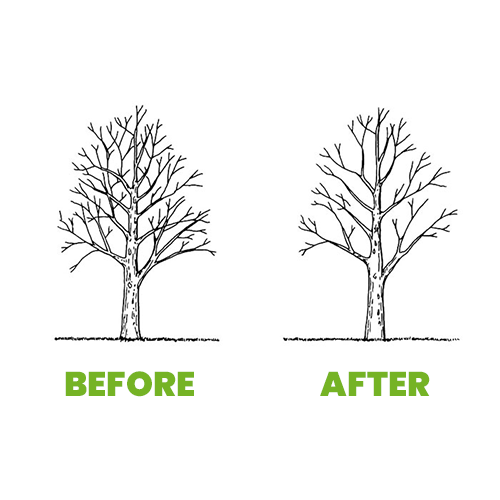 CROWN-THINNING
CROWN-THINNING
Crown-thinning is simultaneously the most basic & the most important form of trimming trees. Because some trees grow more rapidly than others, how frequently this should be done ranges from about twice per year to once every few years. “Crown-thinning” can be defined as the removal of a conservative amount of secondary branches (not any major limbs) evenly throughout a tree — typically 25-30% of the canopy. A more aggressive crown-thin can sometimes be justified, but it is not recommended except for the hardiest of tree varieties, and not if it can be avoided by more thinning. If there is any uncertainty as to how frequently or how aggressively to crown-thin a particular tree, a Certified Arborist can help to make a game plan for your tree care.
A properly crown-thinned tree is beautiful! As with a good hair trim, observers hardly notice it has been done unless ‘before and after’ photos have been taken. Aesthetics aside, a proper crown-thin can also offer greater peace of mind. The best way to judge whether a tree is due for a crown-thin is to look up into the canopy — actually try to look THROUGH the canopy — to see how much of the sky is visible through the foliage of the tree. If it is so dense that one cannot hardly see any of the sky beyond the tree, crown-thinning is definitely recommended. WHY? Because if you cannot easily see through a tree’s canopy, then the wind also has a hard time blowing through it. Most of the time this is not a big problem. However, if a storm comes through, then all the sudden there is potentially a huge problem — one that is too late to fix. The Arizona monsoon season is known to be accompanied by microbursts that unpredictably strike certain areas with particularly strong winds. To compare the canopy of a tree to a ship’s sail, a wise sailor does not keep full sails up in a nasty storm. A dense canopy will offer much resistance to heavy winds, and the unfortunate result of this is breakage of limbs or even loss of the entire tree. The effects of strong winds are exacerbated if they come following a great amount of precipitation, because the roots cannot hold as sturdily in soggy ground. This is one scenario when there is higher risk of a tree being uprooted. There are other problems related to the root system of a tree that contribute to high risk of being uprooted (during a storm or not), but regardless of how the roots may be compromised, proper crown-thinning can significantly lower the risk of a tree falling over.
Crown-thinning may also help with other, more minor issues. For example, crown-thinning will allow more sunlight through to the grass or other plants growing under a large shade tree, which makes for a healthier lawn or shrubs that would otherwise be too shaded. Another such problem that Certified Arborist should be mindful of while performing a crown-thin is the removal of crossing branches — or branches that will eventually cross. If a tree’s foliage is growing very densely, there will likely be crossing branches which will tend to rub against each other with normal shifting (caused by wind or other forces), and as they grow the limbs with cause wounds at points of contact that worsen over time.
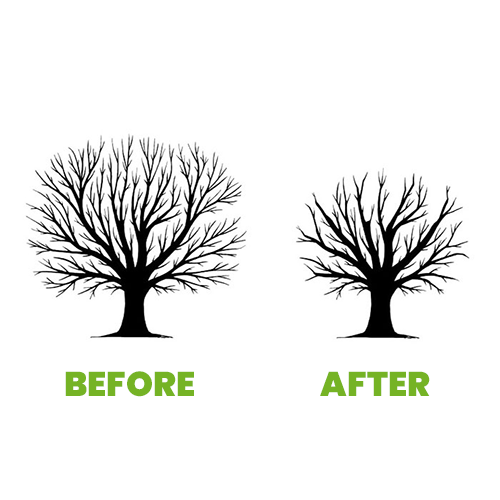 CROWN-REDUCE
CROWN-REDUCE
Crown-reduction is basically reducing the overall size of a tree’s canopy by using reduction cuts on many of the secondary (smaller) branches all around the outside — shortening as many of the limbs as possible. The best application of crown-reduction is when a tree has been planted in a small area. It isn’t uncommon for a sapling tree to be planted with little to no consideration given to how large it may eventually become — which varies depending on the species as well as environmental factors (such as watering and soil quality). Mindful planning of the potential sizes of various tree in a yard is tricky, and if mistakes have been made, crown-reduction can help with overcrowding in the yard. Some trees are kept small purely for artistic reasons as well. Bonsai trees are classic examples of crown-reduction in the extreme, where the growth, the size of a tree, is severely scaled back.
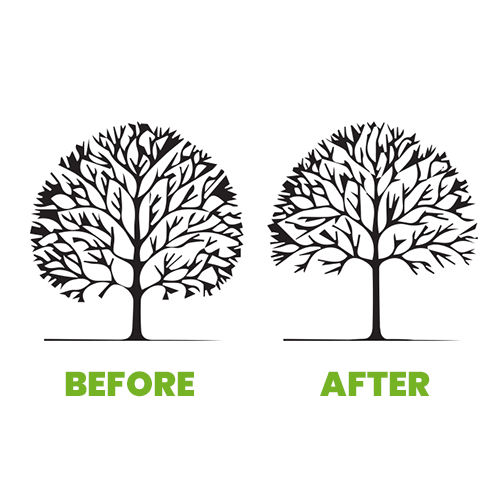 CROWN-RAISE
CROWN-RAISE
The main reason for crown-raising is simply for ease in moving around in the yard. If you find yourself cursing at the poor shade tree every time you go to mow the front lawn, then adequately crown-raising the tree a bit will help.
Raising the canopy will make such tree maintenance as fertilization easier as well. This type of pruning is common over carports or to increase visibility of street signs, as regulated by the city.
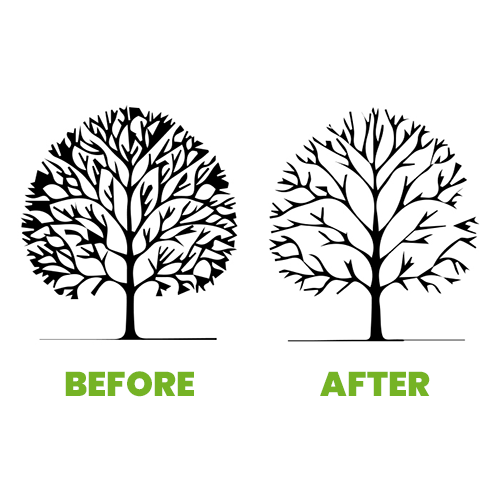 NEVER TOP A TREE!
NEVER TOP A TREE!
A topping cut (sometimes called a “heading cut”) is arbitrary and does not take into consideration the way trees naturally grow. Its evils cannot be overemphasized! Only untrained, inexperienced, or unethical climbers will do this or suggest it be done. Topping is not only ugly, but also causes future structural problems such as dieback or brushy sucker growth at the site of the topping cut. While the topping of certain tree varieties tend to cause a lot of dieback (the topped branch will die back to the nearest crotch, usually), other tree varieties will more likely try to ‘recover’ from the offensive topping cut, compensate for it, but sending out many small suckers that grow just shy of the cut. Nothing can grow out of the topping cut itself, not from the middle of the wood, but rather just behind it, where the bark still surrounds the inner layers of green wood. As these small suckers grow from the topping site, they develop an unsightly brushy appearance. The resultant ugliness, however, is not as troublesome as the compromise in structural integrity. Each of these tiny branches is very weakly attached to the topped branch it grows from. As these branches grow into larger branches they tend to break because of their poor connection with the mother branch (the one that was topped).
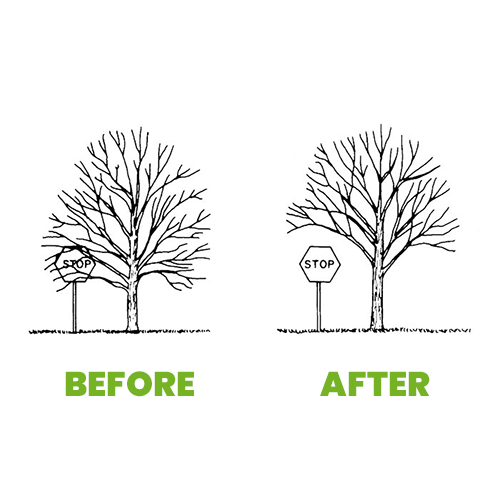 STRUCTURE CLEARANCE
STRUCTURE CLEARANCE
This is reduction of foliage away from (or raising over) buildings, power lines, sheds, fences, pools, or anything else where overgrowth may potentially cause property damage or inconvenience. Whether the worry is roof rats, insect/arachnid pests, clogging of the pool filter, boundary fights with neighbors, or large limbs dropping onto the newly tiled roof, structure clearance will likely be needed on a regular basis for best results as the tree grows.
The earlier a future conflict is foreseen, the easier it is to “train” a tree to grow a certain way (i.e. to promote vertical/horizontal growth, to stay clear of telephone lines, etc). A Certified Arborist can help save you money in the future by bringing such issues to your attention.
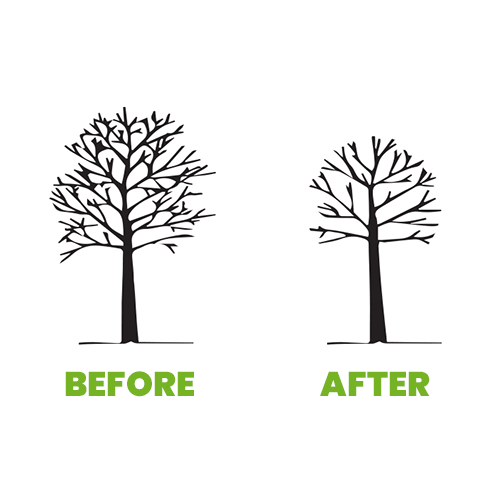 SHAPING
SHAPING
This type of pruning is almost purely aesthetic, a matter of taste, and is rarely necessary for the actual well-being of a tree. It is different from “hedging,” which should be done primarily to, well, hedges. Shaping is often done to trees that tend to have a bushy appearance, such as citrus. It mainly involves reducing limbs that extend much farther from the canopy than those around it. Often any sort of trimming performed by a Certified Arborist will also include artistic considerations, such as roundness, or an overall sense of ‘balance’ or symmetry (or perhaps even asymmetry, depending on the particular tree and the personal preferences of the homeowner). Just like the way you part your hair in the morning, it makes sense to more or less go along with what nature seems to want. The Certified Arborist’s aims are a combination of biology and art, but he or she ought to take into account what the client would like for a tree as well. If it is not harmful to the tree, there is nothing wrong with a little creativity.
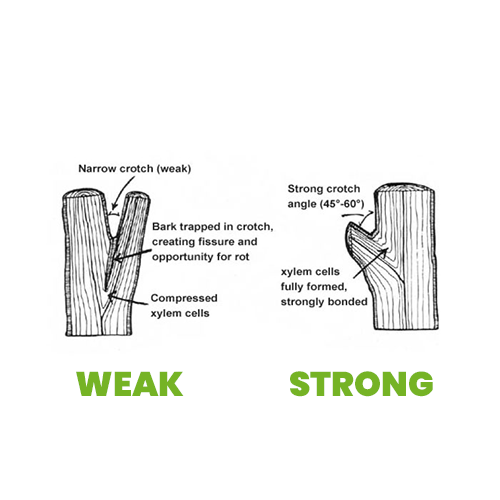 SUBORDINATION OF A CO-DOMINANT LEADER
SUBORDINATION OF A CO-DOMINANT LEADER
Subordination corrects the specific problem of co-dominant trunks (or large, major leaders up higher in the tree). Co-dominant leaders will be similar in diameter, and the crotch between them will typically be V-shaped (instead of the ideal U-shape). The problem with a tight V-shaped crotch is that there may eventually be included bark at the union of the two co-dominant branches, which weakens the crotch until eventually each major leader grows heavier and heavier and they actually split apart. The larger the tree, the more serious the problem is — the more dangerous to the tree itself or the people or animals living nearby. This is especially a concern for trees in close proximity to homes or over carports, where the splitting of a big, heavy tree would cause expensive damage or injury. It is not something that the layman will readily detect, but a Certified Arborist is trained to catch such problems before they even develop. However, if this structural flaw has gone unnoticed or ignored it may be remedied.
Subordination of co-dominant leaders involves choosing one leader or the other to “take over” as the main trunk. Effective correction takes time, sometimes a number of years, because subordination utilizes the natural growth patterns of trees. Basically, the leader that has been chosen as dominant will be left mostly alone. The other leader will be subordinated using heavy thinning. Over time, this subordinated leader’s growth will be slowed, while the dominant leader will increase in diameter. The hoped-for end result is a healthy crotch where instead of a giant slingshot shape there is now a smaller branch growing from a larger trunk. If co-dominance with included bark is too severe to be corrected using subordination, other options include cabling, bracing, or removal of one of the major leaders (which would probably be drastic and leave ugly gaping holes in the look of the tree). Naturally, subordination would be preferable; thus the importance of catching problems before they are critical. If you aren’t sure, have a Certified Arborist look at the tree. This is their area of expertise and most will not charge anything for a consultation appointment.
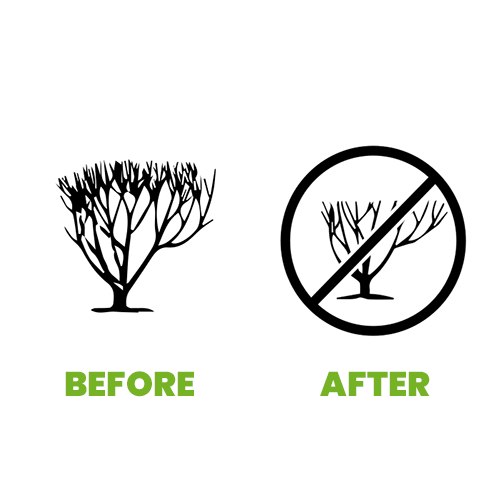 NEVER TOP A TREE!
NEVER TOP A TREE!
A topping cut (sometimes called a “heading cut”) is arbitrary and does not take into consideration the way trees naturally grow. Its evils cannot be overemphasized! Only untrained, inexperienced, or unethical climbers will do this or suggest it be done. Topping is not only ugly, but also causes future structural problems such as dieback or brushy sucker growth at the site of the topping cut. While the topping of certain tree varieties tend to cause a lot of dieback (the topped branch will die back to the nearest crotch, usually), other tree varieties will more likely try to ‘recover’ from the offensive topping cut, compensate for it, but sending out many small suckers that grow just shy of the cut.
Nothing can grow out of the topping cut itself, not from the middle of the wood, but rather just behind it, where the bark still surrounds the inner layers of green wood. As these small suckers grow from the topping site, they develop an unsightly brushy appearance. The resultant ugliness, however, is not as troublesome as the compromise in structural integrity. Each of these tiny branches is very weakly attached to the topped branch it grows from. As these branches grow into larger branches they tend to break because of their poor connection with the mother branch (the one that was topped).
The ONLY type of cut that should ever be made is called a “reduction cut.” With reduction cuts (whether for thinning, shaping, raising, reduction or removal of deadwood) the tree continues to grow in a normal & healthy fashion. A reduction cut is made close to (just after, or distal to) a crotch, so that the growth of the tree will continue in another branch that used to branch off of the reduced one. Pollarding utilizes topping cuts for artistic effect, but it requires great skill & regular maintenance. It is not the same thing as topping a tree. For more information on pollarding, please visit Wild Willow Design.
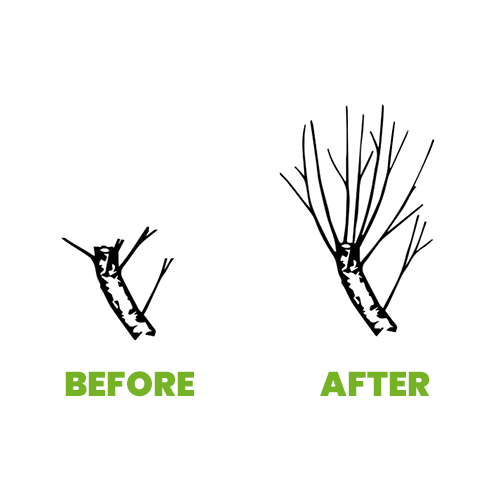 CROWN-RESTORATION
CROWN-RESTORATION
This is an effort to undo the malicious effects of topping cuts. With crown-restoration, the aim is to select one or two of the errant little suckers emerging behind the topping cut to keep, which the growth will continue through; all the rest are removed. Over time, the branches chosen to remain will develop stronger attachments and eventually will no longer pose as great a threat of breaking.
If crown-restoration is done effectively (the sooner the better), then hopefully, over a period of years perhaps, the tree can return to its pre-topping grandeur. Obviously, the best thing to do is to avoid topping trees; but there still is hope & redemption in crown-restoration.
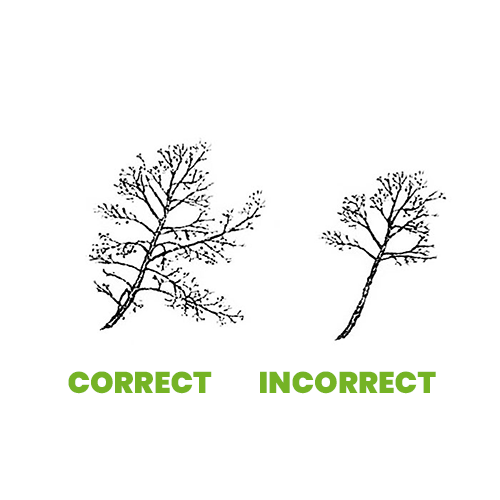 DO NOT “LION TAIL” A TREE
DO NOT “LION TAIL” A TREE
This is most often seen in olive trees or ficus trees. This is when the major branches have been stripped of all their smaller secondary branches except at their tips. The result resembles a lion’s tail — long & thin, bushy at the end. This is not congruent with the natural growth patterns of trees, and, though this is a matter of personal opinion, it is also quite ugly. The optimal taper of a tree’s branches should resemble a carrot’s classical shape.
In a tree branch, this means that the diameter (thickness) is detracted from along its length by having smaller branches branching off from it. A tree that has been repeatedly lion-tailed is evenly slender all along its length, with a lot of weight only at the end. This stress causes breakage, which of course should be avoided.
PREVENTATIVE MAINTENANCE PAYS OFF!
The importance of assessment by a Certified Arborist to determine whether trimming is called for is not unlike that of regular dental cleanings to good oral health. Having him or her help you determine what should be done is the proactive way to avoid future problems. Caring enough about a tree to have it checked by a reputable Certified Arborist and invest some money into it as needed can actually save money down the road, since an experienced Certified Arborist will recognize structural problems before they worsen and become harder (or impossible) to correct. As with a small cavity, the sooner it is discovered and remedied, the better. Root canals or bridges cost much more than filling a small cavity or a simple cleaning. Likewise, a basic crown-thin is typically much less expensive than a tree removal or cleanup of storm damage, for example. A trusted Certified Arborist ought to look young, small trees too. If a property owner values having beautiful, healthy trees around, the appropriate type of trimming is a major aspect of maintaining them.
OUR CERTIFIED ARBORISTS CAN HANDLE ANY TREE PROJECT. SCHEDULE YOUR TREE TRIMMING SERVICE TODAY!
READY TO START YOUR NEXT TREE PROJECT? CONTACT US TODAY AND GET A FREE QUOTE!
